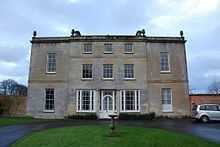Closed 1969 Ages 7–13 or 14 | Gender Boys | |
 | ||
Type Independent prep school Location Bognor Regis (Until 1940)
Codford (1940-1969)
England | ||
Thorpe greenways school tour
Greenways School, also known as Greenways Preparatory School, was an English prep school, founded at Bognor Regis, Sussex, before the Second World War. In 1940 it moved to Ashton Gifford House, Codford, Wiltshire, where it remained until it was closed in 1969.
Contents
History
The school was a prep school for boys, preparing them for the Common Entrance Examination. Boys were divided into two "houses", called Greens and Blues.
In 1928, the school was already established at Aldwick, Sussex, just to the west of Bognor Regis, under Dugald S. Hancock (1897–1963) and his brother-in-law Anthony Maurice Bell. A modern linguist born in the Transvaal, Hancock had been educated at Corpus Christi College, Oxford, with Anthony Bell, and was a fellow of the Royal Meteorological Society. In 1929, the school advertised itself in The Times in the following terms:
ALDWICK, SUSSEX, renowned for its bracing climate, possesses a Modern BOYS' PREPARATORY SCHOOL, Greenways; home atmosphere, health, and good food first consideration; sea bathing, riding. — Write Headmaster.
In 1929, Anthony Bell left the school on his conversion to Roman Catholicism. He then became Dom Maurice Bell , a Benedictine monk of Downside Abbey and Worth Priory, and was headmaster of Worth Preparatory School 1940-1959.
In the 1930s, the school was still operated in Sussex by Dugald and Vivien Hancock (nee Bell), both schoolteachers, but in 1940 it was evacuated to Wiltshire, because of the danger of German bombing on the south coast.
With her husband away from home on Second World War military service, Vivien Hancock took on the role of school principal for the duration of the War, and, as matters turned out, beyond. The daughter of an Oxfordshire clergyman, she became a friend of the poet Siegfried Sassoon, who lived near Codford, at Heytesbury, and was the father of a boy at the school, George Sassoon.
For much of the War the artist Keith Vaughan was stationed at Codford. He painted "The Wall at Ashton Gifford" (1942) "Tree felling at Ashton Gifford" (1942–43), and "The Garden at Ashton Gifford" (1944). He described the school's garden as an "oceanic surging of tangled nettles", with "waist high grass", the wall covered in a "jungle of weed and ivy". The boys' swimming was done in the mill pond at Sherrington.
When Hancock needed money to buy Ashton Gifford House, Siegfried Sassoon lent her £8,000, and he later waived the agreed interest on the loan. In 1944, Sassoon's wife, Hester Sassoon, accused the two of being too close. She also spread such rumours of Mrs Hancock and a local butcher that the headmistress threatened her with a defamation action. The Sassoons separated in 1947.
In 1949 a fire at the school partly destroyed the Victorian service wing of Ashton Gifford House. Vivien Hancock blamed this on an electrical fault, but the cause of the fire was disputed. Shortly afterwards, a Mrs Gibbons took over as the school's headmistress.
In 1956, The Spectator said of Greenways that it was "a Prep School where boys work well because they are treated like human beings and are warm, well fed, and happy." In the 1950s, the school had its own nursery department and kindergarten and was still preparing older boys for Common Entrance and for entrance to high schools.
The school was closed in 1969.
